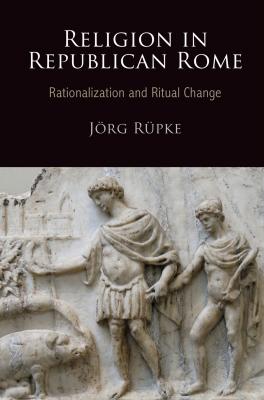Religion in Republican Rome. Jorg Rupke
Читать онлайн.| Название | Religion in Republican Rome |
|---|---|
| Автор произведения | Jorg Rupke |
| Жанр | Религиоведение |
| Серия | Empire and After |
| Издательство | Религиоведение |
| Год выпуска | 0 |
| isbn | 9780812206579 |
Religion in Republican Rome
EMPIRE AND AFTER
Clifford Ando, Series Editor
A complete list of books in the series is available from the publisher.
RELIGION IN REPUBLICAN ROME
Rationalization and Ritual Change
Jörg Rüpke
UNIVERSITY OF PENNSYLVANIA PRESS
PHILADELPHIA
Copyright © 2012 University of Pennsylvania Press
All rights reserved. Except for brief quotations used for purposes of review or scholarly citation, none of this book may be reproduced in any form by any means without written permission from the publisher.
Published by
University of Pennsylvania Press
Philadelphia, Pennsylvania 19104–4112
Printed in the United States of America on acid-free paper
10 9 8 7 6 5 4 3 2 1
Library of Congress Cataloging-in-Publication Data
Rüpke, Jörg.
Religion in republican Rome : rationalization and religious change / Jörg Rüpke. — 1st ed.
p. cm. — (Empire and after)
Includes bibliographical references and index.
ISBN 978-0-8122-4394-9 (hardcover : alk. paper)
1. Rome—Religion. 2. Rome—Religious life and customs. 3. Religion and culture—Rome. I. Title. II. Series: Empire and after.
BL803.R87 2012
| 292.07—dc23 | 2011046059 |
Contents
1. The Background: Roman Religion of the Archaic and Early Republican Periods
2. Institutionalizing and Ordering Public Communication
3. Changes in Religious Festivals
4. Incipient Systematization of Religion in Second-Century Drama: Accius
6. Writing and Systematization
7. The Pontifical Calendar and the Law
8. Religion and Divination in the Second Century
9. Religion in the Lex Ursonensis
10. Religious Discourses in the Second and First Centuries: Antiquarianism and Philosophy
11. Ennius’s Fasti in Fulvius’s Temple: Greek Rationality and Roman Tradition
12. Varro’s tria genera theologiae: Crossing Antiquarianism and Philosophy
13. Cicero’s Discourse on Religion
14. Greek Rationality and Roman Traditions in the Late Republic
Introduction
Roman religion as we know it is largely the product of the middle and late Republic, the period falling roughly between the victory of Rome over its Latin allies in 338 B.C.E. and the attempt of Italian peoples in the Social War to stop Roman domination, resulting in the victory of Rome over all of Italy in 89.
Impelled by sea changes in the nature and structure of the Roman aristocracy, and itself helping to consolidate, channel, and constrain those changes, Roman religion was transformed over this period. The inventions and revisions then undertaken might be separately classified and analyzed under rubrics like ritualization, routinization, systematization, even abstraction, skepticism, Hellenization, and modernization. In this book, I shall argue that the bulk of this change might helpfully be understood as rationalizing: rules and principles were abstracted from practice; these were made the object of a specialized discourse, with its own rules of argument, and institutional loci; and, thus codified and elaborated, these then guided future conduct and innovation.
Let me make one thing clear at the outset. The evidence does not permit us to say, and I will in any event not argue, that all change in this period was systematic or purposive, or that it was driven by processes in the intellectual sphere. The massive changes that took place in Roman ritual life in the late fourth century, when sweeping accretions were made to an earlier calendrical and topographically localized ritual system, are a case in point. As I shall describe and attempt to explain in Chapter 2, these changes should be seen as driven in the first instance by varied political motives. But in the period that followed, and continuing throughout the third century, religious changes exhibit a logic that is the product at once of their formation in a particular place and time, and also of their subjection to discursive control. What we know of them, what they became, is the result of their revision and performance under the rationalizing and systematizing pressures of late middle republican religious discourse, processes that gained momentum down to the end of the Republic. This is the development described and analyzed in this book.
Rationalization
Even superficial examination of the final two centuries of the Roman Republic, from c. 240 to 40, reveals an urban society experiencing rapid change in several areas—social, political, juridical, economic, and religious—in connection with large-scale political and economic expansion and massive cultural imports, especially of tastes and practices understood as Greek.1 This process has been described in terms of escalating conflict in the political arena and as a (partial) modernization in the cultural arena. Most often, it is described in terms of an accelerating Hellenization of both Roman culture and Italian urbanism, and a concomitant decline of tradition, leading to the end of the Republic and a breakdown of republican Roman religion. This study calls
